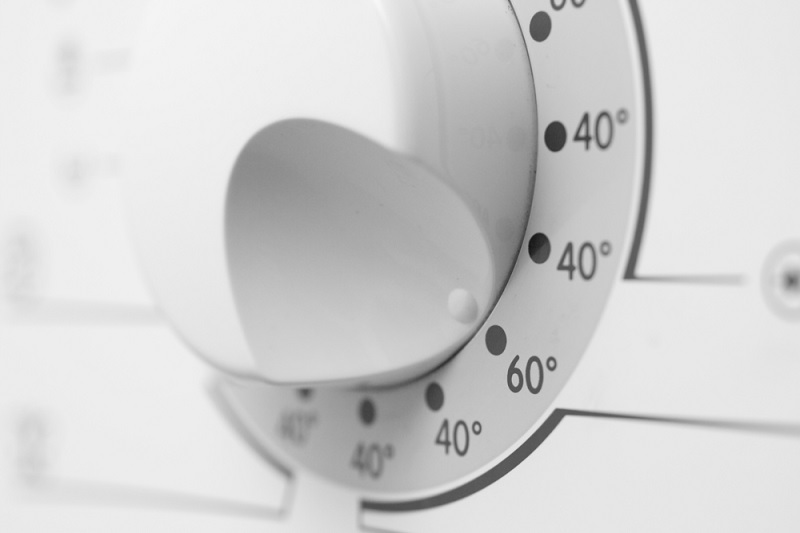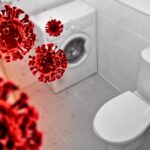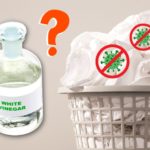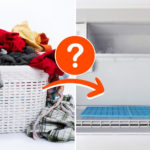The inside of a washing machine is the perfect breeding ground for bacteria and germs! And while you might think that running continuous cleaning cycles through the machine must wash away the microorganisms growing inside, you’d be wrong. There’ll still be bacteria thriving in the washing machine!
What’s more concerning is, if you don’t clean the bacteria out of the washing machine properly it sits and festers, and eventually it’ll transfer onto the next load of laundry that you pop into the machine.
So, if you clean your socks and pants first then your tea towels, you could potentially spread the germs onto the towels you use to dry the dishes. This type of cross-contamination could prove dangerous if it’s not taken care of.
What Temperature Kills Bacteria in the Washing Machine?
Most experts agree that a temperature of at least 60℃ is needed to kill bacteria in the washing machine.
Several NHS hospitals including Royal United Hospital Bath recommend washing at 60°C to prevent the spread of infections.
According to GP Dr Pixie McKenna, quoted in the Mail Online, 60 degrees or above is best for killing germs:
“Doctors recommend washing at 60 degrees or above to kill germs. When washing at lower temperatures, add a laundry disinfectant such as Dettol to your wash to kill bacteria.”
The same article quoted a study that found that laundry washed at 40 degrees only had 14% fewer germs after washing than before, demonstrating that 40 degrees isn’t enough to kill a substantial number of bacteria.
The 60 Celsius figure is also backed by the scientists at stain remover brand Dr Beckmann. According to Dr Beckmann spokeswoman Susan Fermor: “Tests have proven that washing your clothes at 60°C, with a good detergent, is perfectly adequate to kill bacteria.”
So, there is a general consensus that if you’re washing clothes with just general detergent and water, you need to use a water temperature of 60℃ or more to remove large amounts of bacteria from your laundry.
However, washing at 60 alone doesn’t mean that all the bacteria will be eradicated from your dirty washing. Some germs can withstand hot temperatures and can live on, even if they’re exposed to scorching water.
The only way you can be sure that your laundry is as free as possible from any type of bacteria is to launder the items with a laundry sanitiser, like Dettol Laundry Sanitiser, Persil Antibacterial Laundry Sanitiser, or a bleach-based item.
Tip: Keep in mind that not all items of clothing can be washed with bleach. So, check the tags on your garments before you proceed to wash these clothes in bleach.
In some cases, if you use a laundry disinfectant, you can lower the water temperature. This, of course, helps to reduce your running costs. But if you’re going to do this, you should think about pre-treating stains on clothes beforehand, this’ll ensure that you get an even better clean by the end of the wash.
Tip: You should make a point of washing towels, underwear and bedding on a high temperature – 60℃, in separate washes and with a laundry sanitiser.
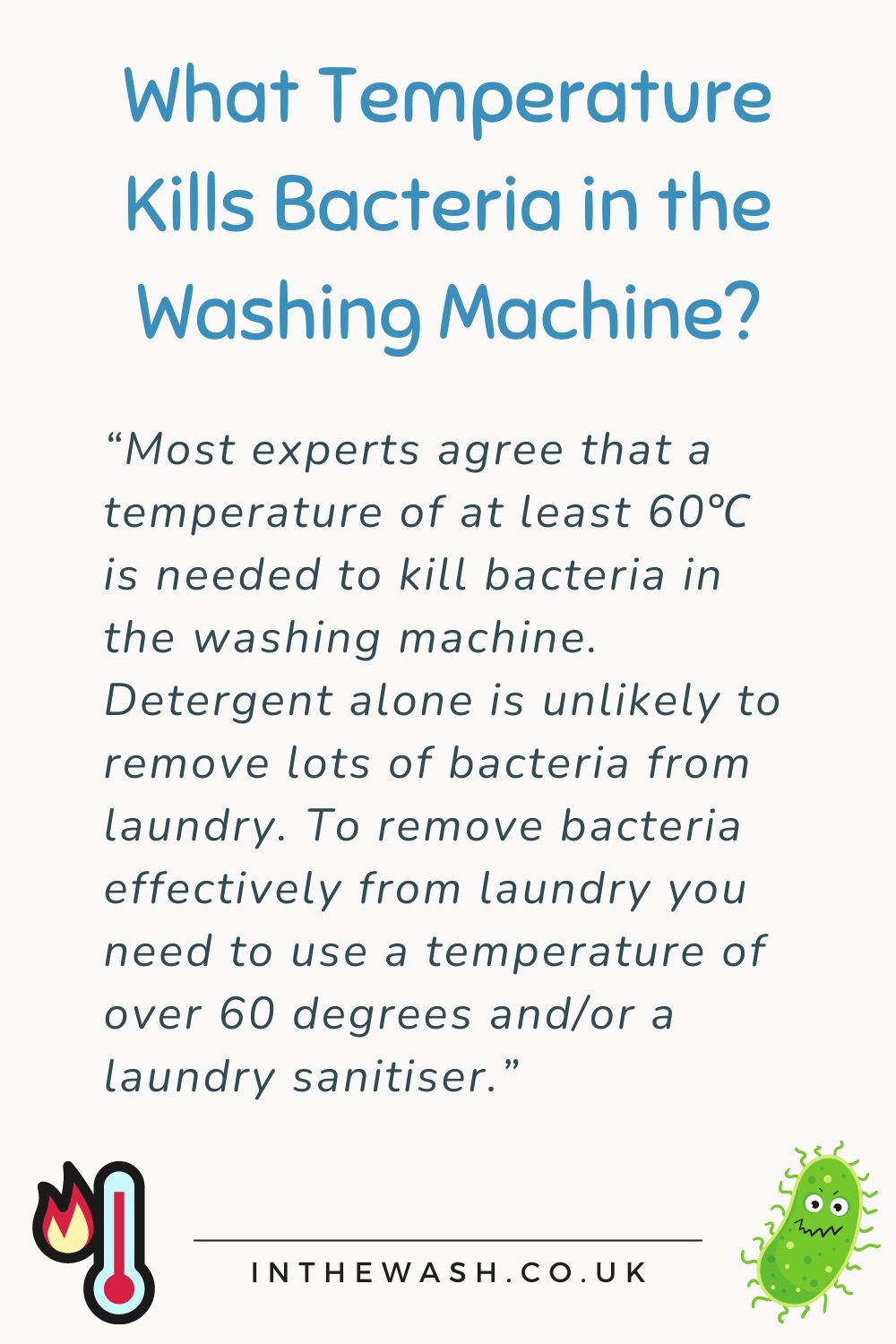
Removing Bacteria from the Washing Machine Itself
To get rid of bacteria from a washing machine itself, you should run a maintenance wash/self-clean wash. This program is designed to flush out pathogens from a washing machine.
The water during this cycle varies from one machine to another, but generally the temperature of the water is above 60℃, but could be as high as 90℃.
Not sure if you have a self-clean/maintenance program? Check out our dedicated article to find out more about maintenance washes and self-cleans.
If you don’t have this feature, you should run a hot wash between 60℃-90℃ through your machine to kill bacteria.
If you want to be certain of killing bacteria, you should also use a specialised cleaner, as hot water alone may not be enough to destroy some germs.
Keep in mind that you can’t really wash most clothes at 90℃ as it will damage them, so the appliance needs to be kept empty when you use this cycle. It’s also worth noting that maximum temperature cycles use a lot of energy, so they won’t be as friendly on your wallet in comparison to lower temperature cycles.
In addition to the temperatures listed above, you also need to clean your entire washing machine on a monthly basis to limit the spread of bacteria. You will need to wash the whole machine during this time, and this includes the drum, the filter and the seal, for example.
Ideally you should use a mixture of homemade remedies to clean your machine, and you should buy specialised washing machine cleaners for the job. This will ensure that your washing machine is as free from bacteria as possible.
Dettol Washing Machine Cleaner, for example, not only kills bacteria, but also removes limescale and poor odours from the appliance.
For a full step-by-step guide on cleaning a washing machine see our guide.
Further to the above, you can also keep bacteria at bay when you’re washing laundry too. Sanitising laundry as it’s being washed limits how many germs get transferred from your clothes and into your washing machine. You can learn more about this below.
If you combine regularly maintaining your washing machine with using specialised cleaning products and making sure you sanitise your dirty washing, your appliance should be as free from bacteria as possible.
How to Limit Bacteria in the Washing Machine
It’s impossible to be 100% on top of the bacteria in your washing machine. However, you can keep its presence to an absolute minimum by practising the following steps:
- Clean your washing machine out on a regular basis and do spot cleans in between – pay attention to the seals, drawer and drum.
- Separate your laundry according to what the clothes are to limit cross-contamination between items – towels, bedding, underwear and t-shirts, for example.
- Use antibacterial laundry sanitisers.
- Leave the door on your washing machine open between cycles.
- Clean your hands after you’ve loaded up the washing machine with dirty laundry – this stops germs from spreading onto other surfaces in your home.
- Don’t leave washed laundry sitting in a washing machine for too long after a cycle has ended – tumble dry or line dry the items as soon as you possibly can to prevent mould and germs building up.
- Remove obvious dirt from laundry before you stick items in the wash – clumps of dirt and hair, for example. This muck will only get caught up in the machine. And if it’s not cleaned away, it will find its way onto the next pile of washing you add to the machine.
- Think about where you house your washing machine – a humid and warm environment is the ideal place for bacteria to set up home.
Can Washing at 20°C Kill Bacteria?
A cold wash alone will not remove bacteria from your washing machine or your laundry. A wash at 20℃ with a laundry sanitiser that stipulates it can be used and is effective at this temperature will do the trick though. Always read the small print on the bottle and follow the instructions!
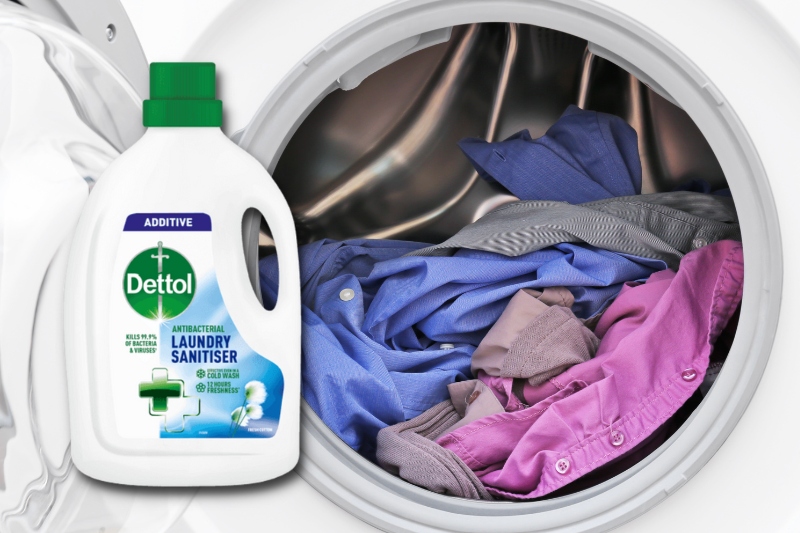
Does Detergent Alone Kill Bacteria?
Detergent alone is unlikely to remove lots of bacteria from laundry. To remove bacteria effectively from laundry you need to use a temperature of over 60 degrees and/or a laundry sanitiser.

In The Wash is your guide to the best laundry and cleaning products, tips and tricks. Our mission is to solve the UK’s cleaning and laundry dilemmas!
